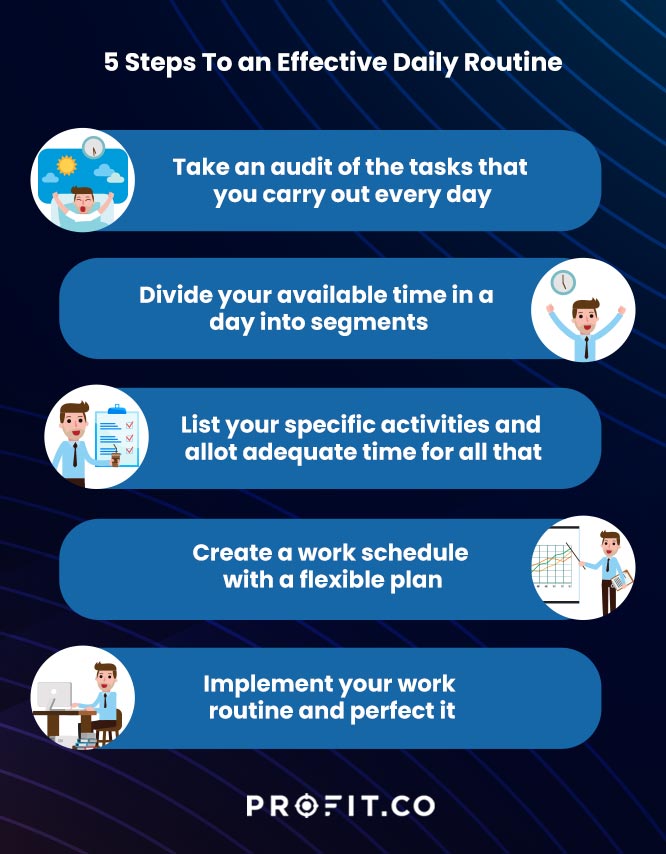Productivity is one of the key factors that determine the success of an individual’s career. Producing the most amount of outcomes using the least resources and minimal time is the core of productivity. But to increase productivity, you have to get in the groove with the work, avoid distractions and remain focused on the task at hand, and more importantly, you need to know when to carry out a particular task to complete it most efficiently.
All these do not come naturally. They result from carefully cultivated habits and behaviors that you can replicate and perfect day after day. This is why having a work routine is important. Work routines introduce discipline and efficiency into work and help individuals achieve goals. No wonder the daily routines of the most successful people are something that people are eager to read about, understand and replicate.
Within this Blog, you will find
- Work routine meaning
- Importance of a daily work routine
- How to create a good daily routine?
- 5 steps you can take to build an effective daily routine
- 12 Best practices for a routine to improve productivity
- Daily routine – example
- Daily routine FAQ
Work routine meaning
A daily work routine is a set of behaviors aimed at achieving and accomplishing tasks in the most efficient way when practiced daily. It is a pattern of habits, activities and behaviors that govern how an individual plans a task schedule and decides which task should be done at what time of day. The aim of practicing a daily routine or productivity planning is to consistently be at your productive best so that you can remain focused on your goals.
A work routine starts as a conscious effort to follow a regular schedule and carry out similar tasks every day at the same time, but it becomes natural as you keep practicing it over time. Once you create and follow a good daily routine, everything falls into place automatically and you need not make a painstaking effort to increase productivity. You can complete tasks efficiently and achieve impressive results by strategically structuring your schedule to fit into your daily routine.
While a daily routine is meant to be followed every day, it is only a rough outline rather than a guideline that should always be strictly followed. As a result, it is acceptable to break a routine at times. This gives you the flexibility to weather unforeseen challenges and prioritize important tasks that are not in your schedule but require immediate attention.
Importance of a daily work routine
14 reasons to have a good daily routine:
- It helps you prioritize the right task at the right time to complete every single task efficiently.
- It helps you allocate more time for the tasks you love and get over the uninteresting tasks quickly.
- Providing you with more time for interesting tasks, a work routine makes your work more engaging.
- It gives you a good head-start to a day’s work with a productive mindset and positions you to be at your productive best throughout the day.
- By pushing you to prioritize tasks based on your interests and the importance of tasks, it helps you better understand your goals and interests.
- By enabling you to find time and accommodate tasks aimed at health and well-being, such as workouts or yoga, in your daily schedule, it lets you manage your health and fitness.
- It saves you from the stress caused by working inefficiently and continuously without a plan and failing at tasks.
- It lets you enjoy a better work-life balance as you manage to prioritize work and meet deadlines and spend more time at home.
- By providing you with more time for rest and leisure, it promotes better sleep and overall well-being.
- It lets you accommodate planned breaks at work and have better interactions with your colleagues, which will come in handy when working as a team.
- By keeping you focused on goals and tasks in hand, it trains you to avoid distractions habitually and avoid unhealthy habits that hinder you from being productive.
- Helping you achieve discipline at work, a daily routine makes you successful and inspires you to do more.
- By enabling you to be the best and most efficient in whatever you do, it promotes better career growth and extends the possibilities and boundaries of success that you are capable of attaining.
- It makes you work smarter to complete tasks within the allocated time and pushes you to find creative solutions for your problems, making you more innovative.
How to create a good daily routine?
Creating a daily routine based on a standard template or following a successful person’s routine is not advisable. Adopting a routine that does not suit you well can backfire. So it is essential to consider various factors, such as the nature of your work, lifestyle, current work schedule, abilities, etc., before creating a custom work routine for yourself. You can make a good daily routine, which you can follow every day without much difficulty, by following these 5 steps.

5 steps you can take to build an effective daily routine
- Take an audit of the tasks that you carry out every day
To start making a work routine, you have to start by noting down the list of tasks that you have to complete every day, both big and small. This can include the tasks that you do at home from the time you wake up, all the way through the work you do at the office, and then the work you do at home once you are back from work, till you sleep. This activity helps you clarify your daily activity without trying hard to recall everything while creating the routine.
- Divide your available time in a day into segments
There are certain times in a day when you are energetic and productive, and there are times when you feel low on energy and drained. So you have to allocate different types of tasks for various times of the day. You can primarily divide your day into three. Beyond that, depending on your daily schedule and varying energy levels, and ability to focus at various times, you can divide them further into subcategories and complete tasks.
You can divide your day into:
Morning
Morning is the time when you feel energetic. It is also the time when you have to rush through your morning tasks at home such as physical fitness, cooking, etc., and get to work. When you get to work, you would still be brimming with energy. So you can schedule your most difficult tasks that require focus and energy – tasks you would usually like to postpone – and get them done quickly in the morning before your energy levels would eventually dip. Completing those tasks in the morning prevents them from making the rest of your day hard. If you schedule them at a later time, you may be unable to do those tasks quickly and efficiently. They will consume more time and make work uninteresting. So the morning is the right time to complete those tasks.
Noon
Noon is usually the time when you feel low on energy and lethargic post-lunch. During this time you can schedule uninteresting and repetitive tasks that are easy to do without thinking too much. Activities such as filling out forms, completing surveys, answering emails, or scheduling meeting appointments can be done at noon.
Evening
The evening is the time when you wind up things at work, plan for the next day, prepare for meetings and presentations, and then spend time with family back at home. Even at home, you can prepare for the next day, by ironing your clothes and keeping everything ready for the next morning.

By failing to prepare you are preparing to fail.
- List your specific activities and allot adequate time for all that
Once you have the main segments and other sub-categories of your routine, you can start laying out specific activities and place them in time slots to create a schedule. You can create a detailed schedule as follows.
Morning pre-work routine
6.30 AM – Wake up and brush
6.45 AM – 7.15 AM – Yoga
7.15 AM – 7.45 AM – Shower
7.45 AM – 8.00 AM – Breakfast
8.00 AM – 8.30 AM – Drop the kids at school
9.00 AM – Arrive at the office
9.05 – 9.10 – Coffee
9.10 AM – 9.15 AM – Go and greet the team members
9.15 AM – 9.25 AM – Make a to-do list and create a plan for the day
9.30 AM – start work - Create a work schedule with a flexible plan
When you have a list of tasks, you can schedule the most difficult and challenging tasks in the morning hours when you will be most productive. Keep your least productive time slots for specific tasks that are repeated and uninteresting. However, work does not always go as per the schedule. It almost always involves having to accommodate unexpected and urgent tasks that require your immediate attention. You should keep your schedule flexible enough to accommodate changes. You can keep some small pockets of time in your schedule empty so that you can postpone the less important tasks when you get some urgent and important work. That way you can make up for the lost time.
- Implement your work routine and perfect it
Implement your routine and try it for a brief period, say a month. Verify its effectiveness and see if the tasks that you scheduled in specific time slots fit in with the time and if you can get those tasks done efficiently within specified time. See if you can regularly follow the schedule without any issues. If you have problems with carrying out certain tasks at certain times, try rescheduling them and changing the routine. You can compare how well you got through the tasks by following different variations in the schedule. You can tweak the daily routine based on those comparisons until you can perfect it. Initially, it might be difficult to adjust to a daily work routine and follow it. But once everything falls in place you can get through tasks quickly and efficiently.
Every individual has to be organized to improve their daily productivity, just like how the OKR framework is a goal management platform that allows organizations to define their objectives and track them through key results for efficient execution. Book a free demo with our team to learn more about how OKR software can optimize your organization’s performance!
12 Best practices for a routine to improve productivity.
- To follow a daily routine without fail, you have to start your day at the right time in the first place. To start your day at a specific time regularly, you have to first sleep and wake up on time every day.
- By waking up early every day, you can get additional time to work with. When you have more time, you do not have to force fit all your tasks within a tight schedule. This additional time lets you get through your tasks in a more relaxed manner.
- Morning is the time when you need to be high on energy. So make sure that you do not skip breakfast. Otherwise you may reach the workplace without the energy required to start the day doing the most difficult tasks.
- Make a list of tasks that need to be completed in a day and sort them according to their importance and complexity. Schedule the most important and complicated tasks in the morning. Complete the most difficult tasks first thing in the morning so that you can go through your remaining tasks more easily till the end of the day.
- When you have similar tasks, bunch them together so that you can complete them at a stretch without losing focus.
- Take regular breaks and create room for those breaks in your routine. It helps you get recharged and concentrate better on the work at hand. You can use this time to walk within the premises for a few minutes, drink water, or to get refreshments.
- Identify your distractions and make sure that your workspace is free from them. For instance, if social media distracts you every once in a while, you can keep your mobile inside the desk drawer or your bag where it is not visible.
- Even when you opt for taking those distractions during your break, make sure that you set time limits for your breaks and strictly follow them, i.e. if you scroll through social media during a break, you have to lock the mobile and drop it in the bag by the end of the break as per the schedule, no matter what.
- Workplace interactions are not necessarily limited to emails. You may also have to participate in work-related conversations in the premises and within software systems such as the OKR system or internal social media feed. You can schedule these tasks in the noon time around lunch, as they do not require unwavering focus and concentration.
- You may have to take up urgent, unforeseen tasks on most days. However, your productivity depends on how well your tasks fulfill your goals. Anything that does not contribute to your goals must be considered a distraction. You can deny such requests and stick to your routine during those instances.
- Review your tasks, progress towards your goals, and accomplishments you made in a day when you complete your work in the evening. This helps you verify your efficiency in completing tasks and helps you get better. It also helps you to find areas of improvement in your daily routine.
- You can end the day by creating a list of tasks for the next day.
Daily routine – example
FAQs
- What is a daily routine?
A daily routine is a set of habits and behavior that you carry out in the same order to get tasks done efficiently and be at your productive best.
- What is an example of routine work?
Following is a work routine example.
- Wake up at 6.00 AM.
- Brush teeth and gargle.
- Do workouts and yoga.
- Freshen up and shower.
- Have breakfast.
- Drop children at school.
- Drive to work and reach by 9.00 AM.
- Review the list of ongoing tasks and new tasks.
- Check the calendar for meetings and appointments.
- Make a schedule for the day.
- Do project work.
- Take a break at 11.00 AM.
- Restart project work at 11.15.
- Lunch at 1.00 PM.
- Read emails and reply after lunch.
- Call clients, fix appointments, and report the progress.
- Speak to the manager and review your goals.
- Complete project work.
- Review achievements and progress against goals.
- List down ongoing tasks to continue tomorrow.
- Pick up children from school at 5.00 PM.
- Go home.
- Play board games for 30 minutes.
- Help children with lessons.
- Eat dinner at 8.30
- Watch TV
- Sleep at 10.00 PM
- How can I improve my work routine?
You can improve your work routine by:
- Evaluating and testing your current routine.
- Setting achievable but ambitious goals
- Creating a schedule
- Verifying how efficiently you are doing every task in the current order.
- Moving the tasks that could not be completed within the time limit to different time slots.
- Putting the routine to test for a short period.
- Re-evaluating and perfecting again and again
Final Thoughts
Today we live in a world where boundaries are challenged and new and evolved ways of working have emerged. However, one thing that remains constant is the need to improve and scale productive output both personally and professionally. The need to work on a routine will go a long way in a happy healthy progressive work life balance. You can get started on Profit.co completely free today to learn about OKRs and How they can help you manage your goals to perfect execution.
